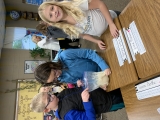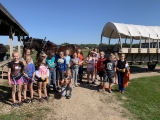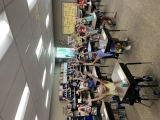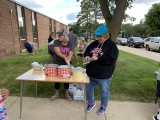-
Category 1
Selected in 2020
-
Grades: k - 12
School Setting: rural
Town Population: 900
Student Enrollment: 260
Student Demographics:
Black/African American: 0%
Teacher/Student Ratio: 1:10
White/Caucasian: 92.4%
Hispanic: 6.8%
Hawaiian/Pacific Islander: 0.4%
Asian: 0.4%
Native American: 0%
Other: 0%
% Reduced Lunch: 14%
% ELL Learners: 1%
Founded: 1880 -
PRINCIPAL:
Lisa Parry -
CONTACT:
306 Main St
Arlington, SD 57212
605-983-5597 ext. 3
Lisa.Parry@k12.sd.us
Arlington Elementary School
Arlington, SD
Any change—for the better or the worse—is incremental, and those striving for improvement must show patience.
- Describe the most successful activity your school has initiated to strengthen ties to your community.
-
Our various communication systems help bind us to our families and stakeholders. Each Wednesday, we send home a paper or digital folder (patrons indicate their preference) that includes grade reports, classroom updates, district information, and even community notices. This, coupled with access to updated online grades, makes it easy for everyone interested in academic performance to stay up to date. In addition, we utilize a School Reach phone program that allows us to disseminate time-sensitive information. This was especially helpful when we were forced into remote learning.
We also invite our families in several times a year—or at least we did until COVID-19 hit. Traditionally, our year kicks off with an Open House/Curriculum Night, our teachers invite families in each fall for conferences, and our Title team hosts a Fun Night each winter. These opportunities help us build and maintain relationships with our stakeholders. - Describe your philosophy of school change or improvement.
- Any change—for the better or the worse—is incremental, and those striving for improvement must show patience. As James Clear notes in his bestseller Atomic Habits, change does not come as some cataclysmic event. Rather, it is the result of hundreds…maybe thousands…of little changes over time. As a district, we adjust our teaching practices, our curriculum, our technology, etc., and then we give these changes time to produce results. The same is true when thinking about our people. We recognize we may not see great gains right away in our students or staff members, but this cannot provoke us to abandon our interventions or professional development commitments. It can take time for the proverbial light bulb to turn on, and when it does, the waiting seems well worth it.
- What are your school’s top two goals for the next year?
- Our school’s goals remain the same from year to year: to help our students see themselves as and improve as communicators and mathematicians and to help our students respect themselves and others. Every road we travel with our students leads to this destination, and we aim to equip every Cardinal with the skills and knowledge necessary to be a productive citizen in an ever-changing society.
- What is the single most important factor in the success of your school that others could replicate?
- Our school culture is rooted in, among other principles, the relentless pursuit of and appropriate support for our students. The academic excellence we have achieved is not the result of some “teaching method of the month” or even of our carefully selected curriculum. Instead, we can trace our student achievement to the day-in, day-out hard work of planning for, engaging in, and assessing student learning. Every district could commit to this and while improvement can take time to demonstrate, in time it will certainly be evident.
- Describe the program or initiative that has had the greatest positive effect on student achievement, including closing achievement or opportunity gaps, if applicable.
-
Arlington Elementary's Title I reading and math programs are critical to student success. Our staff of one full time and one part time Title teacher as well as one full time Title paraprofessional devotes itself to students who need individualized support but do not qualify for special education. These students benefit from small group and one-on-one instruction during the school day. They also have the opportunity to work with support staff as part of an after-school program.
It is important to note deliberate and dynamic student grouping is foundational to effective student support. Using formative and summative assessments, we determine student needs and create small groups for our teachers and paraprofessionals to target. Especially important is our willingness to recreate groups as new information emerges, new opportunities present themselves, and new academic expectations are imposed.
- Explain how ESEA federal funds are used to support your improvement efforts.
- Our Title funds support those teachers and paraprofessionals who, on a daily basis, pinpoint and address our students’ individual needs. Without these dollars, we would not be blessed with the staff members who make a difference in these kids’ daily school experience. In addition, Title funds provide for ESY services. This need is more critical now than ever as we try to compensate for the months we missed due to COVID-19 and the closure of our schools.
- Identify the critical professional development activities you use to improve teaching and student learning.
- In the recent past, we have focused on ACES (adverse childhood experiences) and their impact on our students (and perhaps our staff), technology for distance learning, and extracting data from NWEA MAPS testing. Each of these provides a different lens through which we can examine our district, and because these focuses are quite varied, there is something for each staff member to embrace. Some of us gravitate toward the social-emotional aspect of teaching and learning, and the ACES training gave us new insight and empathy. Others are looking for ways to effectively and seamlessly incorporate technology into our teaching—especially in this new dawn of forced distance learning—so we explored Google Classroom and SeeSaw. Still others are data-driven, and the MAPS satisfied our appetite for objective information useful in decision making.
Stats
-
Category 1
Selected in 2020
-
Grades: k - 12
School Setting: rural
Town Population: 900
Student Enrollment: 260
Student Demographics:
Black/African American: 0%
Teacher/Student Ratio: 1:10
White/Caucasian: 92.4%
Hispanic: 6.8%
Hawaiian/Pacific Islander: 0.4%
Asian: 0.4%
Native American: 0%
Other: 0%
% Reduced Lunch: 14%
% ELL Learners: 1%
Founded: 1880 -
PRINCIPAL:
Lisa Parry -
CONTACT:
306 Main St
Arlington, SD 57212
605-983-5597 ext. 3
Lisa.Parry@k12.sd.us









